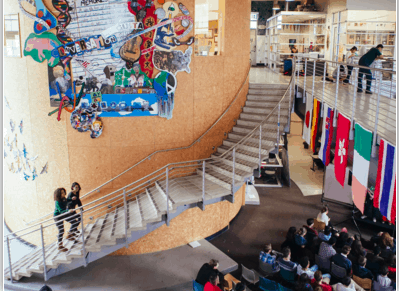Generic vs Coherent Teacher Prep

Graduate schools of education offer an assortment of courses that provide broad exposure to historical concepts in education and human development, yet are often divorced from practice. There’s some benefit to a survey approach but it often does not add up to preparation to lead a great classroom or school.
We’ve inherited sedimentary layers of local, state and federal EdPolicy–not a system designed one to prepare young people for the idea economy and not an easy system in which to teach. In contrast we know that good schools are coherent–everything is mission-aligned to benefit teachers and students.
A Coherent School
One of the best examples of a coherent school is High Tech High (HTH) in San Diego. It was formed around four design principles: personalization, adult world connection, common intellectual mission, and teacher as designer. Everything at the school–structure, schedule, staffing, systems–works together for for students and teachers.
“Most of life is a project and exhibition,” said High Tech High founder Larry Rosenstock. Trained as a lawyer, Rosenstock taught high school carpentry. Larry’s maker ethic is baked into the frequent exhibitions of authentic work at High Tech High.
Rosenstock thinks we should ask students to use their head, use their hands, make things and think about things; that students should spend more time on production technology than consumption technology. Rosenstock thinks school be about be revealing and uncovering–not just covering content. He thinks students should do field work and demonstrate their learning.
Students in the 13 school HTH network cover less material than traditional schools but they trade superficial knowledge for deep understanding. Scan HTH projects and you’ll appreciate that these learning experiences are memorable for a lifetime.
The famous school network is featured in the documentary film Most Likely to Succeed. Producer Ted Dintersmith is engaging students, parents, teachers and administrators on a 50 State Tour.
From HTH to GSE
In 2006, HTH was the first charter network to launch a graduate school of education. Like the school network, the GSE attacks three standard practices: tracking, isolation from the adult world and separation of thinking and doing.
HTH GSE “prepares educators to design and to assume leadership in programs with a parallel commitment to equity, rigor and relevance for all students.” Network schools serve as clinical sites for learning “an opportunity to take risks, reflect on practice and shape their own vision for effective teaching, learning and leadership.”
The HTH GSE offers a one year hybrid online leadership academy program, two year teacher credentialing program (while teaching) and a masters degree in education (one year full time or two years part time). GSE also offers three day institutes, workshops, online courses, tours and a journal.
Purpose-built Professional Training
While HTH GSE was among the first purpose-built graduate programs, several more have recently emerged.
Launched in New York in 2011, Relay GSE has a “curriculum that emphasizes the teaching and instructional leadership skills that have the greatest impact on student learning.” Rather than design principles, Relay reflects a framework of teacher and leader competencies identified at KIPP, Achievement First and Uncommon Schools. More than 1,400 educators take blended courses (about 40% online) offered on nine campuses. Online courses are offered on Coursera.
WGU offers online credentialing and master’s programs and is the largest provider of math and science teachers in the country.
TEACH-NOW serve 650 candidates with an an online program that “focuses on equipping, enabling and empowering teachers to be resourceful problem solvers through a collaborative, activity-based learning system in a dynamic and diverse world.”
Trends in Teacher Prep & Development
Historically, most aspiring educators paid for expensive preparation programs and then paid for a masters degree in order to qualify for an early career pay bump. There is some movement toward subsidized preparation for high potential candidates including Americorps awards, district/network contributions and debt forgiveness.
There is growing micro-credential momentum. Relay provost Brent Maddin thinks it will be common to earn degrees and micro-credentials simultaneously. Post certification growth will increasingly be signaled with stackable micro-credentials. This will encourage more just-in-time learning from several different sources.
Maddin notes the big “got it, do it gap” in education–a teacher candidate may have conceptual knowledge but it may not translate into effective classroom practice. For that reason Relay uses classroom video extensively. Developments in virtual reality and immersive environments will make applications like ASU’s Quest2Teach a common practice environment supported by a social-professional network. These immersive experiences will provide authentic and individualized practice for aspiring teachers that bridges theory and practice.
Design-built programs will increasingly incorporate artificial intelligence to fully personalize the learning experience drawing on comprehensive learner profiles and assisting advisors in crafting customized sequences.
With the proliferation of school models, an increasing amount of preparation and ongoing development (marketed by micro-credentials) will be model specific with strong links to specific networks (like HTH or New Tech Network) or district consortia.
Transformation of Professionals, Schools and Student Learning
When the link to a coherent network is present, such as with High Tech High’s GSE, a purpose-built approach to professional learning sets the stage for:
- Transformation of professionals through opportunities to reflect on practice and shape a vision for leading, learning and leadership is powerful;
- Transformation of schools by building capacity and collaboration around common design principles; and
- Transformation of student learning through a focus on equity, rigor and relevance.
The benefits of purpose-built coherent teacher preparation hold the potential to extend quality learning for all teachers and students.
This post is a part of a blog series in the upcoming “Getting Smart on Rethinking Professional Learning” Smart Bundle produced in partnership with High Tech High Graduate School of Higher Education (@hthgse). Join the conversation on Twitter using #EdLeaders or #RethinkPD and #SmartBundle.
For more see:
- How Project-Based Learning Prepares Youth for Freelance Nation
- Building Micro-credential Momentum
- Competency-Based Teacher Prep & PD
Stay in-the-know with all things EdTech and innovations in learning by signing up to receive the weekly Smart Update. This post includes mentions of a Getting Smart partner. For a full list of partners, affiliate organizations and all other disclosures please see our Partner page.






lynne
This is so very sad. Children are not a commodity & schools are not businesses (even though it's clear that some regard them as a cash cow). Teachers inspire when they deeply understand the subject and also the children in their care. Huge pieces are left out of the teacherless, over-technified, harsh charter-like discipline of these unintellectual "schools" & programs sited. The creepy micro-badges in place of deep learning are horrid and a slap in the face to those who have studied deeply in order to truly understand. All the "vision for leadership" nonsense is such an obvious screen for "we're taking over here but we'll call all you teachers leaders to keep you from understanding that we are de-professionalizing your life's work". We don't want uninspiring teachers or minion children so please let real teachers teach children and allow business to train their specific skills AFTER kids get a job. Our country will suffer greatly if these low level, short-sighted notions replace true, honest & questioning styles of teaching & learning.
Replies
Tom Vander Ark
Hi Lynne, you lost me. My points:
1) good schools are coherent; they either create that on their own or are part of a coherent network;
2) most teacher prep is a buffet that leaves teachers unprepared to teach in good schools
3) teachers deserve great preparation relevant to the environment in which they choose to teach, and that appears most likely to happen in a mission-aligned program.
Tom Vander Ark
See Tom Arnett's post on integrating prep into school networks
http://www.christenseninstitute.org/the-case-for-integrating-teacher-preparation-into-k-12-schools/